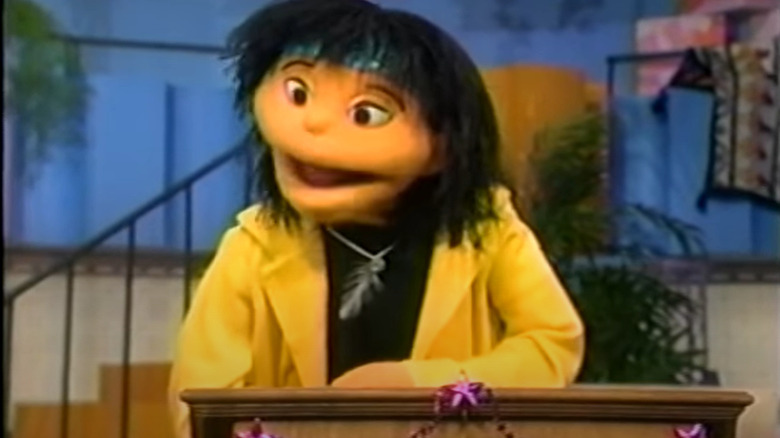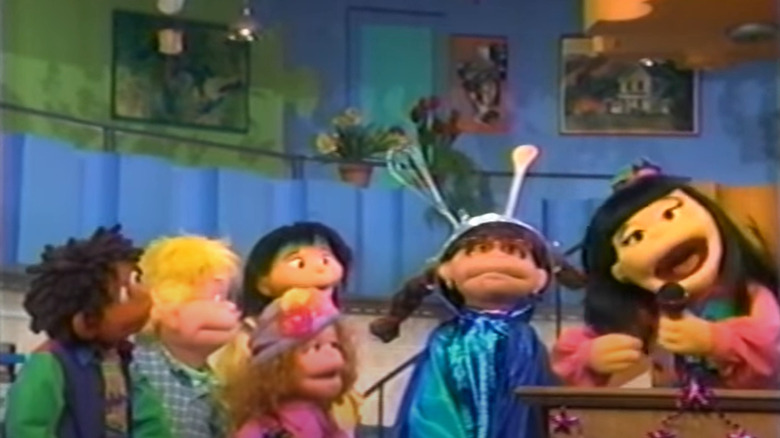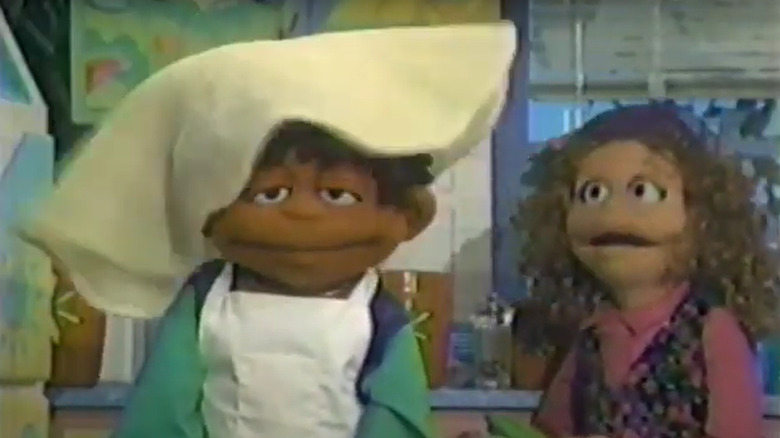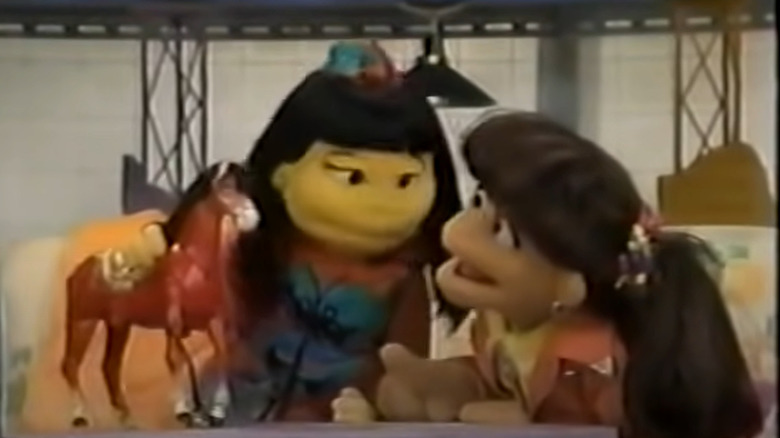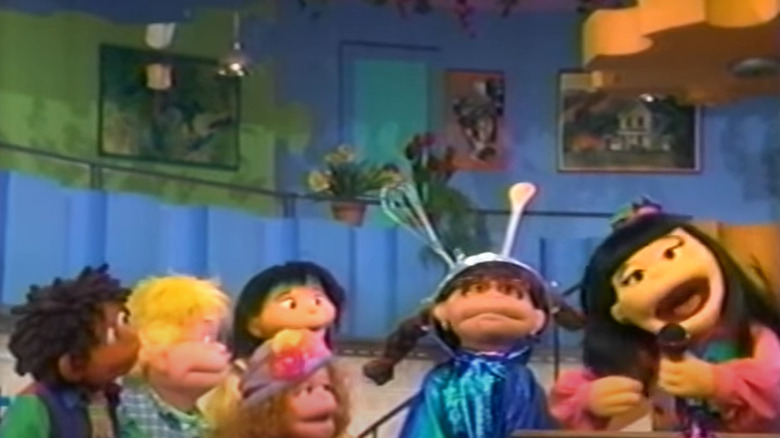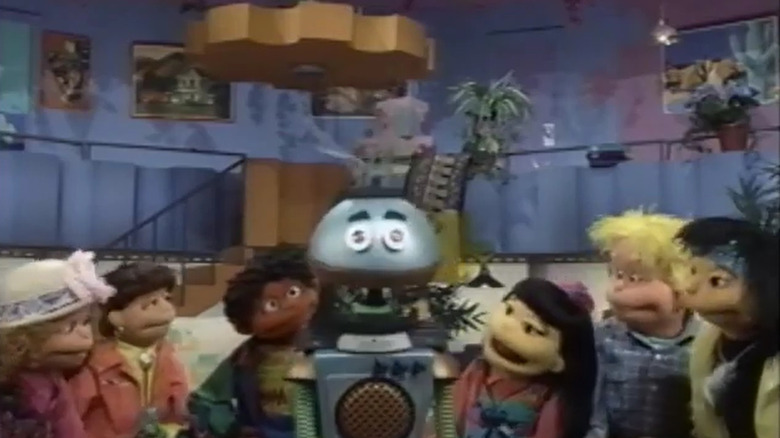What Happened To The Puzzle Place?
If there was a list of '90s shows that shaped young minds without receiving the credit they truly deserved, "The Puzzle Place" would certainly have a spot at the top. "The Puzzle Place" — a world where a diverse cast of Muppets tackle hard-hitting, real-life issues like racism, prejudice, and bullying — was insanely popular. But perhaps the most puzzling part of the show's legacy is how it all together up and just mysteriously disappeared one day.
Charged with the task of bringing diversity issues to the forefront of American preschoolers (per the Los Angeles Times) and fitted with a budget that could make even purple dinosaur Barney blush (via The Spokesman-Review), "The Puzzle Place" was certainly a lesson to be learned through cinema, for viewers and producers alike. In the words of beloved character Julie Woo, "It's a place where we hang out and share and have fun."
So then, why isn't it around for the kids of today? Here's a look at this vintage children's television program, from where it was then to where it is currently and where it stands on major mainstream issues.
The Puzzle Place was produced specifically to address social inequalities
In January of 1995, the Los Angeles Times, when discussing "The Puzzle Place," reported, "The $10-million-plus series for preschoolers is designed to promote racial harmony and self-esteem." The timing of the series, which aired promptly in 1994, coincided with the American timeline of racial tension stirred by violent incidents of police brutality and schoolyard discrimination, among other things.
In a collective effort to prevent a future filled with further discrimination, television executives teamed up to craft a new narrative, and much of this message was to be spewed from the mouths of Muppets hailing from a wide array of different ethnic, religious, and racial backgrounds. The star-studded cast of "The Puzzle Place" featured Chinese-American socialite Julie Woo, Mexican-American extrovert Kiki Flores (notedly also the voice of "Sesame Street's" Rosita), Native American nature lover Skye Nakaiye, devout Lithuanian-Jewish Muppet Jody Silver, German-Norwegian agriculture enthusiast Ben Olafson, and the thoughtful African-American city dweller Leon MacNeal. Together, they would meet up at "The Puzzle Place" to learn that while each of their journeys is unique, they are not too different to be friends. In fact, their differences served to solidify their friendships and their unique journeys throughout the series, with the intention of inspiring children worldwide to do the same.
It received one of the largest grants of all time for children's television
With such a daunting task in mind, producers projected an astronomical price tag for "The Puzzle Place". According to Kidscreen, PBS expected to spend at least $10.3 million in 1991 to produce the pilot and subsequent 40 episodes for the highly-anticipated 1st season. To put things into perspective, during that same time period, the PBS mega-hit show "Barney & Friends" debuted at a fraction of that price for approximately $2.6 million (via The Washington Post).
In one of the biggest grants gifted to a kids' show, the Corporation for Public Broadcasting contributed a whopping $4.5 million towards the production of diversity via "The Puzzle Place." The grant was not only a charitable contribution from the company but also a win for the pilot, which competed against 30 other high-profile proposals for the funds. Additionally, Edison International provided $3.5 million, feeling that the show's message could serve as a conversation starter for their movement to rebuild Los Angeles through social justice. But even with the wins and the fistfuls of cash, the production budget had a major multi-million-dollar shortfall — a deficit from the very beginning.
Underfunding overshadowed the show's important message
So, what were the bells and whistles that came with the multimillion-dollar budget? Well, for starters, there was the behind-the-scenes team featuring masterclass puppeteers, many of whom had already achieved success on other hit Muppet shows such as "Sesame Street." Among them were Matt Vogel (better known as the voice of Big Bird), Carmen Osbahr (whose unforgettable vocals brought life to Rosita), and even Noel MacNeal, who had a hand in projects ranging from "The Teenage Mutant Ninja Turtles" to "Eureeka's Castle" (via IMDb). Even "The Puzzle Place" guest stars were household names at the time, with the likes of Sinbad, Patti LaBelle, and Terrence 'T.C.' Carson of "Living Single" all gracing the screen to put the puzzle pieces together.
On a production level, these class acts would prove highly successful, but once the full picture was revealed, it became clear that the ultimate price for such expenses would be the show itself.
It was the second-most popular kids show of that era
"The Puzzle Place" is one of those pieces of cinematic history that proves that sometimes popularity is just not enough to remain on the air. A 1995 quote from Business Wire later reported by Blippee said that the reputable program "enjoyed an average audience-per-viewing second only to 'Barney & Friends' among shows in the popular PBS daily children's block." Adding a major boost to this were the characters themselves. The beloved Muppet cast members were making special in-person appearances everywhere from suburban shopping malls to other hot shows like "Good Morning America." According to Kidscreen, they even made the occasional appearance on First Lady Hillary Clinton's White House lawn.
When the "Puzzle Place" characters weren't fighting racism and cultural bias or showing up for photo ops with the rest of the rich and famous, they were busy being nominated for prestigious film awards. In 1996, the show won a UNIMA Citation of Excellence for Recorded Media (via UNIMA).
Today, The Puzzle Place is missing too many pieces
Much like with a real puzzle, one missing piece can ruin the entire picture. In the case of "The Puzzle Place", there were many missing pieces that caused the series to simply fall apart. According to DefunctTV, some of the major glitches included a general lack of funding, uncertainty regarding rights to distribution, and main character actors branching off onto other shows. In its heyday, the series aired in multiple different languages in countries all across the globe, projecting a myriad of relatable race issues into the hearts of young viewers. Yet even the reruns came to a screeching halt at the onset of the 2000s as a new generation was born with complex problems all its own.
In the end, more than half the original episodes of "The Puzzle Place" are completely unaccounted for — digitized images floating around an unused VHS tape reel. They may be lost forever, but to '90s kids, the all-encompassing message of acceptance still remains to this day.
